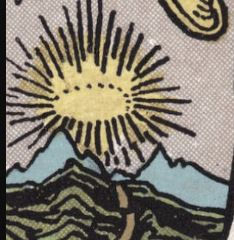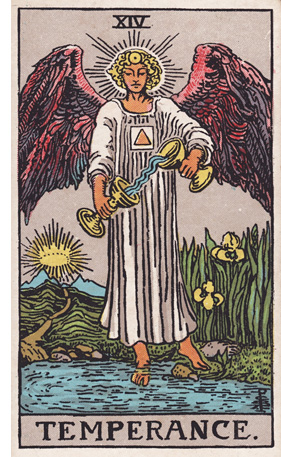Every card represents an aspect of humanity that has echoed through time. In this series we are going to dive into the history of the imagery found within the tarot, the meaning of the cards and how that meaning changed over time, and the symbols present within the images of what is arguably the most well-known tarot deck of all time - the Rider-Waite (Smith) Tarot Deck. So, grab your favorite RWS deck, a cup of tea or coffee, and join me live on Sunday mornings over on YouTube as we Deep Dive into each one of the 21 Major Arcana cards continuing now with the last of the cardinal virtues - Temperance.
Temperance, Art, Time, Daughter of the Reconcilers

Temperance - a cardinal virtue that once lent her name to the historical movement dedicated to promoting moderation and, more often, complete abstinence in the use of intoxicating liquor. This allegorical representation of Temperance is from a body of work illustrating the four Cardinal Virtues—the others being Prudence, Justice, and Fortitude or more well known to us Tarot practitioners as Strength. Historically women have always personified the Virtues and remain easily identifiable by attributes and symbols that go right back to the Middle Ages. Here in the work of Pollaiuolo, Temperance carefully pours liquid from one vessel into another, presumably diluting wine with water to suggest moderation. A trop which can be traced back through antiquity to the Greeks. This image directly harkens back to the time of the Greeks as the figure pours wine from a vessel into the traditional 'krater' or wine bowl. This also has an association with the idea of purification as historically water was typically not consumed alone as it was often contaminated so it was either mixed with wine or made into beer to be made safe to drink.

However, this traditional depiction of Temperance that we are so familiar with is not the only historical representation of this virtue. Another traditional depiction of Temperance can be seen in the example to the right of a woman holding a bridle.
Or in the example from a 16th century illuminated manuscript we see in one hand she holds a pair of glasses giving her clear vision. In her other hand she holds the reins of a horse bridle, which is a traditional symbol of keeping one from speaking evil. On her head we find timepiece and beneath her feet is a windmill, both indicating an ability to keep time and maintain an even pace, not too slow, not too fast.

In medieval times it was thought that the body was comprised for four primary humors or tempers: Black Bile, Yellow Bile, Blood and Phlegm. If one of these
tempers was out of balance it was said that you 'lost your temper' which would explain your odd behavior or feeling of malaise. These tempers were the cause and cure of any alignment, and for example you may have been bled should the doctors find that you had too much Blood. The modern meaning of temperance has evolved since its first usage. In Latin, 'tempero' means restraint from anger. More broadly the proper balancing or mixing of compounds, as we see it used in Alchemy and for example the tempering of alloys in metallurgy; hence the phrase "to temper steel", meaning the heating and cooling process of forging a steel alloy.
Visual Evolution
Temperance is one of the Major arcana that we really see take on new form and symbolism over the course of the history of Tarot. In the early Italian decks, we see traditional depictions of Temperance as the Cardinal Virtue. In the historical French decks, we see the change from the figure of a woman to an angelic figure to emphasize the divine nature of The Virtues. As we move into the more modern decks by occultists, we see the addition of other occult and mystic symbolism. In the case of the Thoth Tarot a complete shift away from Temperance and to a new title - Art where we find explicit additions of alchemical symbolism.
Evolution of meaning
Much like the visual evolution of this arcanum. The divinatory meaning of this card grew and evolved over time as well. Starting with more simplistic allegorical associations with the virtue symbolism we see this card grow and evolve over time to include deeper occult and philosophical symbolism in the interpretation of this card. Though it should be noted that it is interesting that our early occultist meanings certainly diverge from both the allegory of temperance, and a deeply psychospiritual meaning, leaving us with some of the most basic interpretations we see within the Major Arcanum during this period.
De Mellet (1781): Temperance. An angel instructs Man on the avoidance of Death.
Levi (1855): The Hebrew letter Nun. Temperance: the Heaven of the Sun, climates, seasons, motion, changes of life, which is ever new yet ever the same.
Mathers (1888): Temperance. Combination, conformation, uniting.
Golden Dawn (1896): Daught of the Reconcilers, the Bringer Forth of the Life. Temperance. Combination.
Waite (1910): Temperance. Household economy, moderation, frugality, management, accommodation.
Crowley (1944): This card represents the Consummation of the Royal Marriage which took place in Atu VI. The black and white personages are now united in a single androgyne figure. Even the Bees and the Serpents on their robes have made an alliance. The Red Lion has become white, and increased in size and importance, while the White Eagle, similarly expanded, has become red. He has exchanged his red blood for her white gluten. (It is impossible to explain these terms to any but advanced students of alchemy.
The Symbols

Winged Angle Waite describes this figure as masculine but "the figure is neither male or female." Though Waite never explicitly identifies the angelic figure many occultists believe this to be the angel Gabriel. His red wings denote him to be a member of the Seraphim. These are the red-winged angels which, with Cherubim, are among the first hierarchy of angels next to the throne of God.
Sun Symbols

In Waite's description of this card he specifically states that the figure has "the sign of the sun upon his forehead." The solar symbolism here can be associated with the Angel Gabriel as the bringing of knowledge and messages. The sun also represents the cars position on the Tree of Life and is associated with Tiphareth, the central sephirot which has associations with Spirituality, Balance, Integration, Beauty, Miracles and Compassion.

Squared Triangle This is the symbol of the septenary - the number seven - to which we can divide the Major Arcana into three septenaries. It is also thought to represent the coming together of the seven virtues; the three theological and four cardinal virtues.
Vessels & Liquid

A traditional representation of the Allegory of Temperance - diluting the wine with water. In further writings by Waite, he describes this as the 'the essence of life' and goes on to describe them as "cleansing water and saving fire. The two cups contain grace, benediction, salvation, and mercy alike."

The Path
The path we see to the right of the card represents the path to a higher state of consciousness we can achieve after we have mastered Temperance.

Mountain

One Foot on Land Waite describes the figure as standing between two worlds, the figure "harmonizes the psychic and material natures."

Tetragrammaton The יהוה we see in the folds of the angelic figure's robes are a direct representation of the Tetragrammaton and the name of God. This could be viewed as the divine authority the figure has as this is the forbidden name of God which orthodox Jews will never say in ritual, prayer, or at all.

Iris
The Iris is a long-standing traditional symbol of messages, connection, bridges, valor, hope, and peace.
As always be sure to check out our live discussion on this very topic over on YouTube:
References
Barbier, L. (2021). Tarot and divination cards: A visual archive. Cernunnos, 2021.
Butler, B. Dictionary of the Tarot. New York: Schocken Books, 1986.
Chang, T. Susan. Tarot Correspondences: Ancient Secrets for Everyday Readers. Llewellyn Pulbications, 2018.
Crowley, Aleister (aleister Crowley). Book of Thoth - (Egyptian Tarot). Red Wheel/Weiser, 2017.
Dean, Liz. The Ultimate Guide to Tarot: a Beginners Guide to the Cards, Spreads, and Revealing the Mystery of the Tarot. Fair Winds Press, 2015.
Decker, Ronald; Dummett, Michael. A History of the Occult Tarot. London: Duckworth, 2019.
Fiebig, Johannes, and Evelin Burger. The Ultimate Guide to the Rider Waite Tarot. Llewellyn, 2013.
Katz, Marcus. Secrets of the Waite-Smith Tarot: the True Story of the Worlds Most Popular Tarot: with Previously Unseen Photography & Text from Waite & Smith. Llewellyn Publications, 2015.
Place, R. M. The fool's journey: The history, art, & symbolism of the tarot. York, 2010.
Waite, A. E. Pictorial Key to the Tarot. Dover Publications Inc, 2005.
Wen, Benebell. Holistic Tarot. North Atlantic Books, 2015.













Comentários